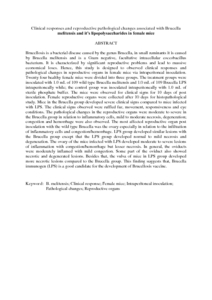Citation
Abdullah, Faez Firdaus Jesse and Adamu, Lawan and Ismael, Nur Aisyah and Osman, Abdinasir Yusuf and Haron, Abd Wahid and Saad, Mohd Zamri and Saharee, Abdul Aziz
(2014)
Clinical responses and reproductive pathological changes associated with Brucella melitensis and it’s lipopolysaccharides in female mice.
International Journal of Animal and Veterinary Advances, 6 (1).
pp. 15-22.
ISSN 2041-2894; ESSN: 2041-2908
Abstract
Brucellosis is a bacterial disease caused by the genus Brucella, in small ruminants it is caused by Brucella melitensis and is a Gram negative, facultative intracellular coccobacillus bacterium. It is characterized by significant reproductive problems and lead to massive economical loses. Hence, this study is designed to observed clinical responses and pathological changes in reproductive organs in female mice via intraperitoneal inoculation. Twenty four healthy female mice were divided into three groups. The treatment groups were inoculated with 1.0 mL of 109 wild type Brucella melitensis and 1.0 mL of 109 Brucella LPS intraperitoneally while; the control group was inoculated intraperitoneally with 1.0 mL of sterile phosphate buffer. The mice were observed for clinical signs for 10 days of post inoculation. Female reproductive organs were collected after 10 days for histopathological study. Mice in the Brucella group developed severe clinical signs compared to mice infected with LPS. The clinical signs observed were ruffled fur, movement, responsiveness and eye conditions. The pathological changes in the reproductive organs were moderate to severe in the Brucella group in relation to inflammatory cells, mild to moderate necrosis, degeneration; congestion and hemorrhage were also observed. The most affected reproductive organ post inoculation with the wild type Brucella was the ovary especially in relation to the infiltration of inflammatory cells and congestion/hemorrhage. LPS group developed similar lesions with the Brucella group except that the LPS group developed normal to mild necrosis and degeneration. The ovary of the mice infected with LPS developed moderate to severe lesions of inflammation with congestion/hemorrhage but lesser necrosis. In general, the oviducts were moderately inflamed with mild congestion. Some part of the oviduct also showed necrotic and degenerated lesions. Besides that, the vulva of mice in LPS group developed more necrotic lesions compared to the Brucella group. This finding suggests that, Brucella immunogen (LPS) is a good candidate for the development of Brucellosis vaccine.
Download File
![[img]](http://psasir.upm.edu.my/36794/1.hassmallThumbnailVersion/Clinical%20responses%20and%20reproductive%20pathological%20changes%20associated%20with%20Brucella%20melitensis%20and%20it.pdf)  Preview |
|
PDF (Abstract)
Clinical responses and reproductive pathological changes associated with Brucella melitensis and it.pdf
Download (168kB)
| Preview
|
|
Additional Metadata
Actions (login required)
 |
View Item |

